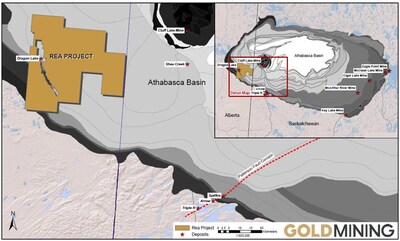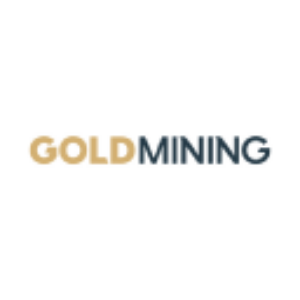GOLDMINING DEFINES AT LEAST 70 KM OF PROSPECTIVE TREND IN THREE CORRIDORS ON ITS REA URANIUM PROJECT, WESTERN ATHABASCA BASIN
GoldMining has announced promising preliminary results from the geophysical survey reprocessing of its Rea uranium project in the Western Athabasca Basin. The Company, which owns 75% of the project, has identified over 70 km of prospective trends within three distinct corridors. The project encompasses approximately 125,328 hectares and surrounds Orano Canada's Dragon Lake prospect. Notable findings include anomalous uranium values and pathfinder elements in multiple drill holes across the Maybelle River, Net Lake, and Keane Lake corridors. CEO Alastair Still emphasized the cost-efficiency and strategic relevance of this work towards unlocking shareholder value. Future exploration will focus on refining targets for drilling.
- Identified over 70 km of prospective trends in three corridors.
- Intersections of anomalous uranium values in multiple historic drill holes.
- Cost-effective reprocessing and inversion modeling techniques used.
- Surrounds the high-grade Dragon Lake prospect, enhancing strategic value.
- Future exploration to refine targets for further drilling.
- historical drilling with only partial exploration in key corridors.
- Uncertain economic viability without further detailed exploration and drilling.
- Dependence on future geophysics and drilling to confirm findings.
Insights
Geological Perspective
The recent preliminary results from GoldMining Inc. on the Rea uranium project present significant geological insights, particularly with over 70 km of prospective trends identified. This is substantial because the Athabasca Basin is known for hosting world-class uranium deposits. The identification of three distinct corridors—Maybelle River, Net Lake and Keane Lake—each with multiple target areas, enhances the project's potential. The use of advanced reprocessing techniques like inversion modeling is noteworthy as it often reveals hidden geological features that traditional methods may overlook.
Understanding the significance of conductive graphite-bearing shear zones is crucial. These zones are indicative of potential uranium mineralization, especially in the context of unconformity-related uranium deposits. The historical drilling results showing anomalous uranium values and pathfinder elements like vanadium, nickel, cobalt and arsenic further validate the geological prospectivity of these corridors.
For retail investors, the geological findings suggest a strong potential for future discoveries, influencing the project's valuation positively. However, it is also essential to note that these are preliminary results and significant discoveries require extensive and often expensive follow-up exploration and drilling campaigns.
Financial Perspective
From a financial standpoint, the preliminary results from the Rea uranium project are promising for GoldMining Inc. The identification of significant prospective trends can enhance the company's portfolio and attract investor interest, potentially leading to increased stock value. Investors typically respond positively to news of advanced exploration projects, especially in regions known for high-grade deposits like the Athabasca Basin.
However, investors should remain cautious until further exploration confirms the potential findings. The initial results suggest promising prospects, but the financial risk remains high until more concrete data and potential resource estimates are available. The involvement of Orano Canada Inc. as a 25% stakeholder is a positive indicator, suggesting credibility and shared risk in the project's future developments.
In the short-term, this news may boost investor sentiment and stock prices. In the long-term, actual value realization will depend on successful follow-up exploration, more detailed feasibility studies and eventual development of the identified resources.
Market Perspective
From a market perspective, the news positions GoldMining Inc. favorably within the uranium exploration sector. The Athabasca Basin's reputation for high-grade uranium deposits means that any significant discovery can place the company in a strong competitive position. The preliminary findings align with market expectations for high-grade deposits in this region, which can create a positive echo throughout the market.
Understanding the dynamics of the uranium market is crucial. The demand for uranium is influenced by factors such as nuclear energy policies, supply disruptions and geopolitical considerations. GoldMining Inc.'s strategic positioning within a high-potential area could attract market interest and strategic partnerships, especially with increasing global interest in clean energy solutions.
Retail investors should recognize that while the market potential is high, the exploration and development phases can be lengthy and capital-intensive. Therefore, a balanced perspective considering both the high potential returns and inherent risks of mining exploration is essential.
Alastair Still, CEO, stated: "The cost-efficient work by our technical team to advance our highly prospective Rea Project is consistent with our strategy of seeking to unlock further value for our shareholders. Our team has applied modern reprocessing techniques, including inversion modelling of the historic geophysical surveys. This work has highlighted the most prospective areas for follow-up exploration, outlined over 70 km within three distinct corridors, each with several target areas displaying geophysical signatures consistent with known
- Reprocessing, inversion modelling and reinterpretation of historic geophysical surveys have identified over 70 linear kilometres of basement conductive trends on the Rea Project, interpreted as graphite-bearing shear zones which are prospective for unconformity-style uranium mineralization in the
Athabasca Basin, in three northwest trending corridors (see Figure 2):- The Maybelle River Corridor (11 km) trending northward from Orano's Maybelle River Project, which hosts shallow high-grade uranium mineralization at the
Dragon Lake prospect.- Five historic drill holes tested a portion of the Maybelle River Corridor on the Company's Rea Project claims, intersecting anomalous uranium values in two holes, and anomalous pathfinder elements and pathfinder minerals including clay alteration and dravite, which is a distinctive accessory mineral associated with many major
Athabasca uranium occurrences, in three of the five drill holes.
- Five historic drill holes tested a portion of the Maybelle River Corridor on the Company's Rea Project claims, intersecting anomalous uranium values in two holes, and anomalous pathfinder elements and pathfinder minerals including clay alteration and dravite, which is a distinctive accessory mineral associated with many major
- The Net Lake Corridor (20 km) has seen only wide spaced drilling (comprising 20 historic holes), with five holes intersecting anomalous uranium values and associated pathfinder elements and minerals.
- The Keane Lake Corridor (40 km) is largely untested except for two historic drill holes that intersected anomalous uranium values in the south-central area of the Rea Project.
- The Maybelle River Corridor (11 km) trending northward from Orano's Maybelle River Project, which hosts shallow high-grade uranium mineralization at the
- Each of the three prospective corridors are interpreted as potentially significant and deeply rooted basement structures, which are known to be fundamental to the formation of Athabasca uranium deposits. Drill-proven fault and shear zones have been intersected on both the Maybelle River and Net Lake corridors.
- Follow-up exploration programs are expected to include additional geophysics to refine targets in advance of drilling.
Unconformity-related uranium deposits in the
GoldMining recently commissioned Fathom Geophysics LLC to process, invert and model historic airborne and ground geophysical surveys that included: Versatile Time Domain Electromagnetics (EM) and magnetic surveys flown in 2005; an Induced Polarization (IP) survey completed in 2006; and a Full Tensor Gradiometry survey flown in 2009. The results of this work were used to manually produce a structural and lithological interpretation consistent with the modelled geophysics and tectonic setting of the Rea Project area (Figure 2).
The Net Lake Corridor (20 km) has been tested by 20 widely spaced drill holes with five of these holes intersecting anomalous uranium and associated pathfinder elements such as vanadium, nickel, cobalt and arsenic, and pathfinder minerals such clay alteration and dravite.
The Maybelle River Corridor (40 km total length, 11 km on Rea Project claims) hosts Orano's Maybelle River project, which includes shallow (<200 m deep) high-grade uranium mineralization at the
The Keane Lake Corridor (40 km) is largely unexplored, except for two historic drill holes that intersected anomalous uranium values in the south-central area of the Project.
Please see the technical report titled "Technical Report on the Rea Property,
1 |
Tim Smith, P. Geo., Vice President Exploration of GoldMining, has supervised the preparation of and approved the scientific and technical information contained herein. Mr. Smith is a qualified person defined in National Instrument 43-101 Standards of Disclosure for Mineral Projects ("NI 43-101").
The Rea Project consists of 16 contiguous exploration permits covering approximately 125,328 hectares surrounding Oranoꞌs Maybelle River project, which hosts the relatively shallow,
The Company is a public mineral exploration company focused on the acquisition and development of gold assets in the
Technical disclosure in this news release regarding the Rea Project has been prepared by the Company in accordance with NI 43-101. NI 43-101 is a rule of the Canadian Securities Administrators applicable to the disclosure of scientific and technical information concerning mineral projects. These standards differ from the requirements of the
Certain of the information contained in this news release constitutes "forward-looking information" and "forward-looking statements" within the meaning of applicable Canadian and
![]() View original content to download multimedia:https://www.prnewswire.com/news-releases/goldmining-defines-at-least-70-km-of-prospective-trend-in-three-corridors-on-its-rea-uranium-project-western-athabasca-basin-302171560.html
View original content to download multimedia:https://www.prnewswire.com/news-releases/goldmining-defines-at-least-70-km-of-prospective-trend-in-three-corridors-on-its-rea-uranium-project-western-athabasca-basin-302171560.html
SOURCE GoldMining Inc.










